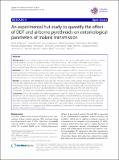| dc.description.abstract | Background
Current malaria vector control programmes rely on insecticides with rapid contact toxicity. However, spatial repellents can also be applied to reduce man-vector contact, which might ultimately impact malaria transmission. The aim of this study was to quantify effects of airborne pyrethroids from coils and DDT used an indoor residual spray (IRS) on entomological parameters that influence malaria transmission.
Methods
The effect of Transfluthrin and Metofluthrin coils compared to DDT on house entry, exit and indoor feeding behaviour of Anopheles gambiae sensu lato were measured in experimental huts in the field and in the semi-field. Outcomes were deterrence - reduction in house entry of mosquitoes; irritancy or excito-repellency – induced premature exit of mosquitoes; blood feeding inhibition and effect on mosquito fecundity.
Results
Transfluthrin coils, Metofluthrin coils and DDT reduced human vector contact through deterrence by 38%, 30% and 8%, respectively and induced half of the mosquitoes to leave huts before feeding (56%, 55% and 48%, respectively). Almost all mosquitoes inside huts with Metofluthrin and Transfluthrin coils and more than three quarters of mosquitoes in the DDT hut did not feed, almost none laid eggs and 67%, 72% and 70% of all mosquitoes collected from Transfluthrin, Metofluthrin and DDT huts, respectively had died after 24 hours.
Conclusion
This study highlights that airborne pyrethroids and DDT affect a range of anopheline mosquito behaviours that are important parameters in malaria transmission, namely deterrence, irritancy/excito-repellency and blood-feeding inhibition. These effects are in addition to significant toxicity and reduced mosquito fecundity that affect mosquito densities and, therefore, provide community protection against diseases for both users and non-users. Airborne insecticides and freshly applied DDT had similar effects on deterrence, irritancy and feeding inhibition. Therefore, it is suggested that airborne pyrethroids, if delivered in suitable formats, may complement existing mainstream vector control tools. | en_US |

